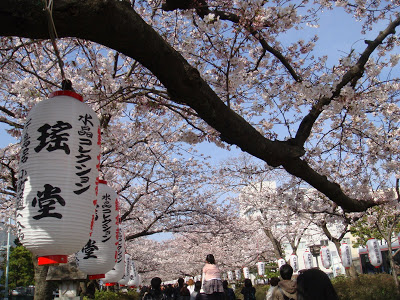 Kamakura retains its status as my favorite place in Japan after another fun day trip. Chris and I looped through its shrines and temples our first week in Japan and
Kamakura retains its status as my favorite place in Japan after another fun day trip. Chris and I looped through its shrines and temples our first week in Japan and 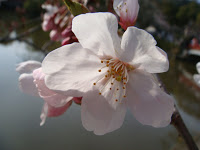 I keep finding reasons to come back. When I first visited the Tsurugaoka Hachimangu Shrine near Kamakura Station for Bean-Throwing Day in February I knew I’d have to come back in spring. On my way yesterday, I saw a shrine I’d never seen from the Enoden Line train—a nostalgic train with wooden floorboards nailed together and big picture windows that runs along the coast—so I hopped off and got my temple book signed in calligraphy characters at the Goryo Jinja Shrine below.
I keep finding reasons to come back. When I first visited the Tsurugaoka Hachimangu Shrine near Kamakura Station for Bean-Throwing Day in February I knew I’d have to come back in spring. On my way yesterday, I saw a shrine I’d never seen from the Enoden Line train—a nostalgic train with wooden floorboards nailed together and big picture windows that runs along the coast—so I hopped off and got my temple book signed in calligraphy characters at the Goryo Jinja Shrine below. 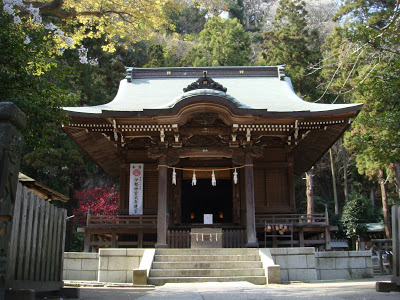 I hopped back on the Enoden at Hase Station (the stop near the Daibatsu Big Buddha and Hasedera Shrine) and continued to the last stop: Kamakura Station. There’s a half-mile walk to the shrine flanked with cherry trees and (in spring) adorned with lanterns. A road and shops parallel the walk on either side, but the cherry blossoms were so think you almost couldn’t even see them. Two giant red torii gates mark both entrances to the lane like bookends.
I hopped back on the Enoden at Hase Station (the stop near the Daibatsu Big Buddha and Hasedera Shrine) and continued to the last stop: Kamakura Station. There’s a half-mile walk to the shrine flanked with cherry trees and (in spring) adorned with lanterns. A road and shops parallel the walk on either side, but the cherry blossoms were so think you almost couldn’t even see them. Two giant red torii gates mark both entrances to the lane like bookends.
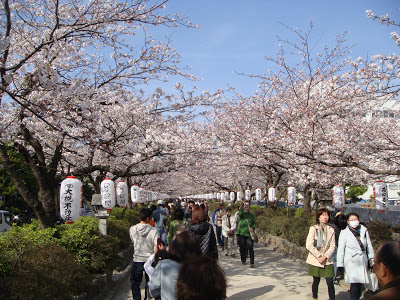 Tsurugaoka Hachimangu has ponds, cafes and little islands linked to the main path with arched bridges. The ponds reflected back the fluffy pink of the cherry trees and turtles, ducks, a crane and an egret all came out to enjoy the warm-ish afternoon.
Tsurugaoka Hachimangu has ponds, cafes and little islands linked to the main path with arched bridges. The ponds reflected back the fluffy pink of the cherry trees and turtles, ducks, a crane and an egret all came out to enjoy the warm-ish afternoon. 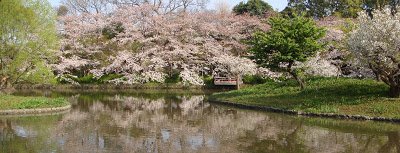
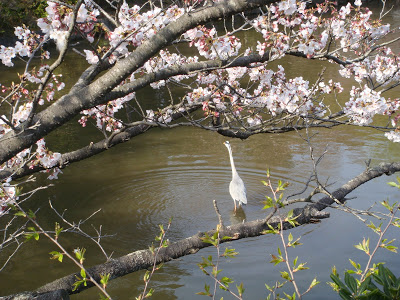
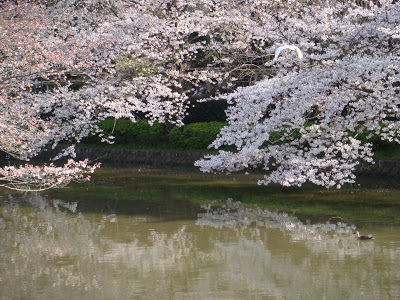
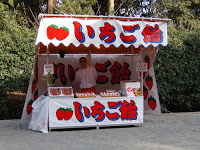 After the lane of cherry trees, there’s a stone and gravel walkway leading to the Jogu Shrine on the top of the stone steps and the Wakamiya Shrine at the bottom that all these ponds and side paths branch out from. Somewhere on the grounds is an old ginkgo tree behind which the nephew of the third Shogun of Kamakura lay in wait in 1219. When Shogun Sanetomo Minamoto happened by, Kugyo assassinated him. The ginkgo is more than 800 years old.
After the lane of cherry trees, there’s a stone and gravel walkway leading to the Jogu Shrine on the top of the stone steps and the Wakamiya Shrine at the bottom that all these ponds and side paths branch out from. Somewhere on the grounds is an old ginkgo tree behind which the nephew of the third Shogun of Kamakura lay in wait in 1219. When Shogun Sanetomo Minamoto happened by, Kugyo assassinated him. The ginkgo is more than 800 years old. 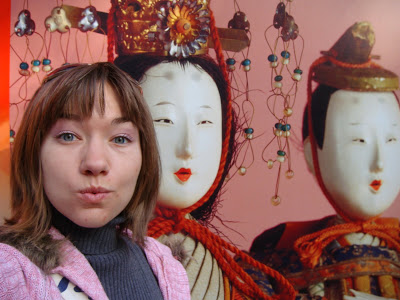
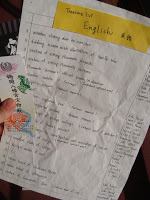 barely got to see them before closing—just in time!! I really like Japanese museums. They’re usually in an interesting place like a shrine or old castle and I can’t read everything, so I don’t stay too long and get a headache. This is especially nice when Chris and I go to museums together because he likes to look at and read every single label and panel. A benefit to being illiterate is not having to read all those facts I’d forget anyway and being able to just appreciate the displays. Hina dolls are traditional Japanese dolls given to girls to celebrate Girls Day March 3. Families amass elaborate displays of these dolls, some of which are very expensive, and bring them all out each Girls Day. Many of the ones on display were from the Edo Period (A.D. 1600 – 1868). The museum also held statuary and shrine and temple adornments, most of them dating from the 1200s to the 1500s. Just sitting there in the open air on a display pedestal and a simple sign asking not to touch. Such a casual attitude about ancient stuff always blows me away with the reminder of how much this country has sailed through and remained more or less the same.
barely got to see them before closing—just in time!! I really like Japanese museums. They’re usually in an interesting place like a shrine or old castle and I can’t read everything, so I don’t stay too long and get a headache. This is especially nice when Chris and I go to museums together because he likes to look at and read every single label and panel. A benefit to being illiterate is not having to read all those facts I’d forget anyway and being able to just appreciate the displays. Hina dolls are traditional Japanese dolls given to girls to celebrate Girls Day March 3. Families amass elaborate displays of these dolls, some of which are very expensive, and bring them all out each Girls Day. Many of the ones on display were from the Edo Period (A.D. 1600 – 1868). The museum also held statuary and shrine and temple adornments, most of them dating from the 1200s to the 1500s. Just sitting there in the open air on a display pedestal and a simple sign asking not to touch. Such a casual attitude about ancient stuff always blows me away with the reminder of how much this country has sailed through and remained more or less the same. 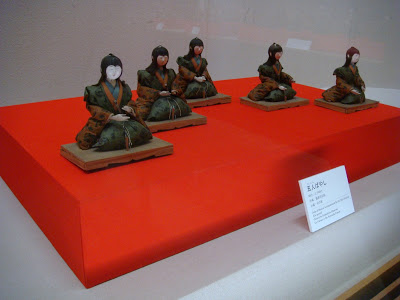 After the museum I ran into that wedding procession, then walked back through the cherry blossom lane as the sun set, then continued straight toward the coast. I found a stationery shop, recycle shop where I bought a zebra-print skirt and a knit tank top and—surprise!—a church!
After the museum I ran into that wedding procession, then walked back through the cherry blossom lane as the sun set, then continued straight toward the coast. I found a stationery shop, recycle shop where I bought a zebra-print skirt and a knit tank top and—surprise!—a church! 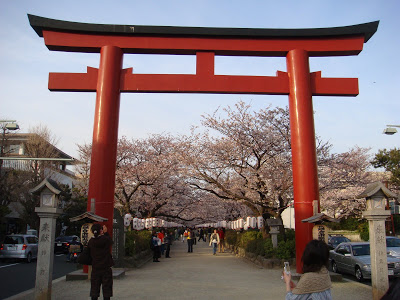
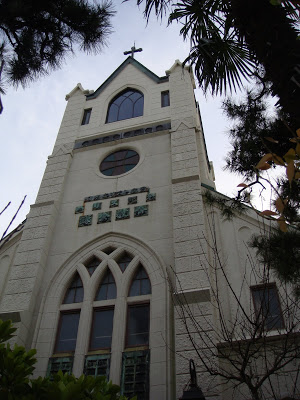 This is the Kamakura Kyokai United Church of Christ in Japan, built in 1926 as the Kamakura Harris Memorial Methodist Church. The plaque says, “The large traced arch windows on the facade of the steeple are in the Early Gothic style, and the building is regarded as being representative of pre-World War II Protestant churches. The belfry, towering over Wakmiya Ohji, plays an important role as a landmark of the Yugihama neighborhood.” That made me laugh—that’s probably NOT the kind of guiding light the church intends to be!
This is the Kamakura Kyokai United Church of Christ in Japan, built in 1926 as the Kamakura Harris Memorial Methodist Church. The plaque says, “The large traced arch windows on the facade of the steeple are in the Early Gothic style, and the building is regarded as being representative of pre-World War II Protestant churches. The belfry, towering over Wakmiya Ohji, plays an important role as a landmark of the Yugihama neighborhood.” That made me laugh—that’s probably NOT the kind of guiding light the church intends to be!
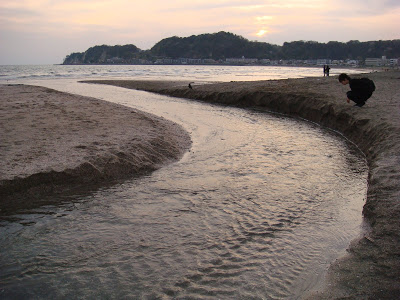
I followed this little stream to the shore and walked along the waterline to where Chris and I found excellent seashells on New Years Day (no such luck this time). A couple holding hands by the water was walking along minding their own business when the girl got dive-bombed by one of the huge hawks always circling the city. Yikes! By then it was dark, so I found my way back to Hase Station and caught the train headed home.
